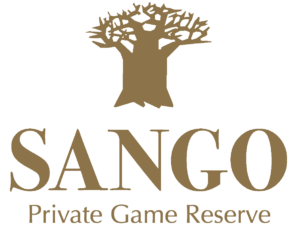Interview
Working with Rhinos: Nicolas Duncan on Wildlife Conservation
Black rhinos are one of the largest and most endangered mammals in Zimbabwe. As a result, they have been the focus of conservation efforts for many years. The peaceful pachyderms are hunted by poachers for their precious horns, and protecting them is complicated and costly. Nicholas Duncan and his Save African Rhino Foundation have made it their mission to protect the animals and ensure their survival.
Mr. Duncan, what led you to your role at Save African Rhino Foundation (SARF)?
It goes back to a leadership seminar in 1987 in Perth, Western Australia, when I set a goal to help African wildlife at some stage in the future. Then, a few months later, I read an article saying that black rhino numbers had declined from 65,000 in 1972 to only 3,500 in 1987. I went to a talk about this a couple of days later. I’ve always liked animals, so I put my hand up at the talk and said I’d like to do something to assist with the rhinos. It turns out that about a dozen people said they were in as well. On the next day, we had a follow-up meeting where we formed the SAVE African Rhino Foundation. That was 36 years ago, and I’ve been involved since day one and president for the last 35 years.
SARF is now a successful conservation player, with every penny raised going directly to rhino conservation. What does that mean in practice?
We tend to back projects that are run by people who we appreciate. In the last three years, and it won’t be any different this year, at least 65% of our funding has gone to Save Valley Conservancy, 20% to Zimbabwe National Parks projects, 5% to Namibia, and 5% to South Africa, with the balance going to other wildlife projects we like.
For instance, for Save Valley Conservancy, we finance the wages of the conservancy’s Special Species Protection Unit (SSPU) with about 35 anti-poaching rangers, some of whom do intelligence gathering, and a little bit goes into fuel and other things. Then, on top of that, when something is needed, which is most of the time, like uniforms, radios, boots, microlight spares, fuel, or anything else, we cover that as well. Another part of Save Valley Conservancy’s spending includes the annual rhino ear-notching operation.
We do the ear-notching in Save Valley every year in August. In 2022, about 17 or 18 rhinos were done, and it’s going to be much the same in 2023. However, next year, it’ll be much better because, at Save Valley, including Sango, they just had a record crop of rhino births: 37 in 2022. This is their best ever, and it’s because of two things: one, our successful anti-poaching measures, and two, there are a few more mothers giving birth to calves.
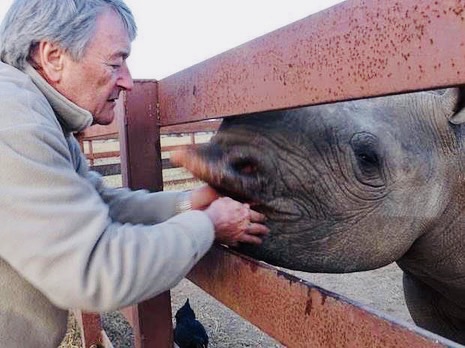
Nicolas Duncan with one of his babies
“Then, a few months later i read an article saying that the black rhino numbers had declined from 65,000 in 1972 to only 3,500 in 1987.”
As you said, SARF is funding the annual rhino ear-notching. Tell us about the process.
Right, we fund that, and it’s quite expensive; about $1,500 per rhino. The trackers set off at 5 am. They’ve got to find the rhino and get it visual, then radio in to say they have their eyes on it, and then the spotter plane goes up, which circles over and above the rhino in case it runs away and the men can’t follow it. The plane walks the men to where it is, and when they’re certain they’ve all got it under control, they radio the helicopter.
The helicopter takes off with the veterinarian on board and flies straight to the rhino. They get down low and behind the rhino and sort of herd it in the direction they want, near a road or track for easy access, and then they fire the dart into its bum, and it goes down about three or four minutes later. Again, they try to herd it to a clearing, and as it’s starting to weave and wobble, they herd it to where they want it to go down. Then, they must find a spot to land, and out they hop and get on with their work. The drugs, the veterinarian time, the helicopter, and all the work that’s done cost about $1,500 per rhino.
It’s only about a 15-minute procedure to do the ear notch cutting and the basic veterinary tests. In the meantime, the tracking crew is out looking for another one. So, you try to do three rhinos a day. You must do it in the early morning or late afternoon when it’s not too hot. It can be too hot in the middle of the day, and that’s too stressful for the animals, especially when they’re being chased by a helicopter. So, we fund that, we’ve funded that for the last three years, and we will do so again this year.
Is there a simple way of explaining what goes into protecting a rhino?
Well, you need well-motivated and well-trained men with good leadership. You need a good intelligence network, so hopefully, you’re one jump ahead. Therefore, you need good communications, be it radios or GPSs, funding for emergency things, vehicles for mobility, and the right kit for the weather conditions.
Above all, you need the desire to succeed. As with any business, if you don’t want to succeed, there’s no point in doing it. However, to be a good, well-oiled machine, you need all the things I just mentioned and an ounce of good luck as well because you’re up against a fairly determined opposition who will stop at nothing to get what they’re after.
Talk us through the security measures you put into place to protect the rhinos at Save Valley and Sango.
Well, it all came about in 2012 when we introduced Pete Clemence and his son Bryce to the authorities at Save Valley. Both men are Zimbabwean legends when it comes to implementing professional anti-poaching projects.
SARF funded their anti-poaching training around National Parks in Zimbabwe for the previous 18 months, and they’d finished that contract, so they were footloose and fancy-free, and I suggested they might like to help save the rhinos in Save Valley and Sango.
As they began working there, they arrived with nothing; no gear, no men, not anything. We just had two old vehicles for them. But Sango founder Willy Pabst and Dave Goosen, who was the Sango manager, gave them Sango’s ten best men to start the new anti-poaching unit up around Bryce. Now, the anti-poaching unit is over 70 men strong growing to around 100 by the end of this year and patrolling every day over this massive area of 120 x 30 km.
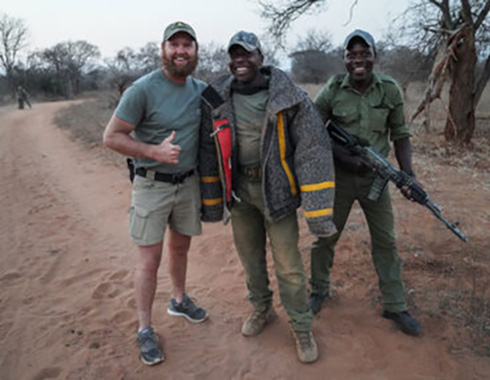
BRYCE CLEMENCE with his team
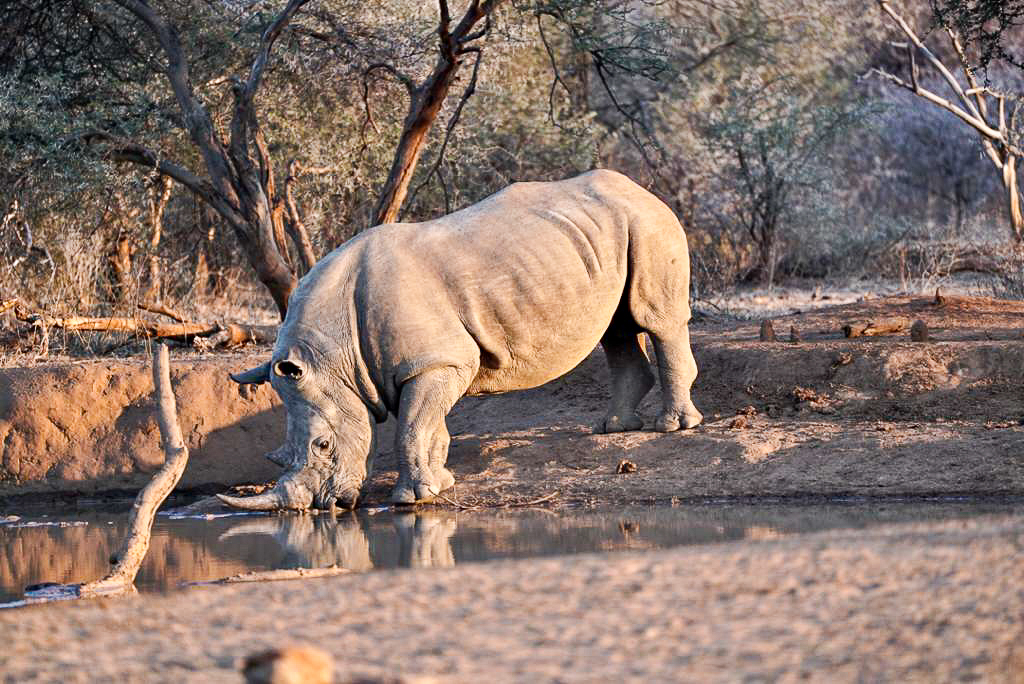
Thanks to SARF, the rhinos on Sango are safe
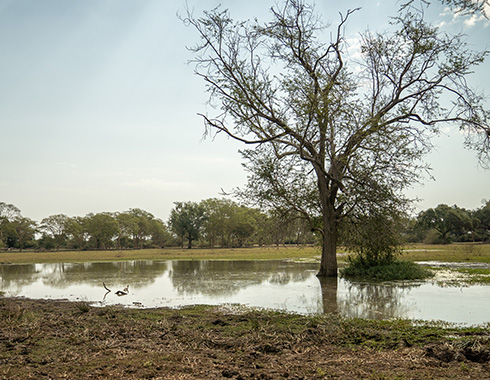
Sango is the perfect habitat for rhinos
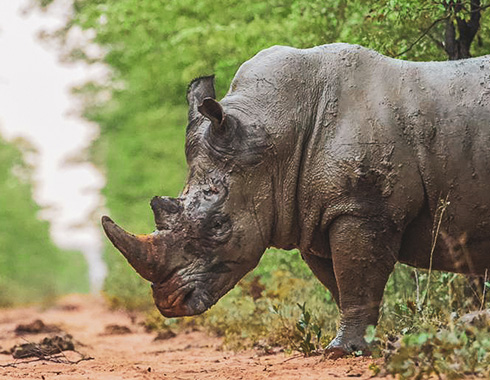
A rhino injured from a fight with a rival.
But the anti-poaching unit is not just made up of people, right?
Absolutely. Besides the current 70 man unit, Bryce has developed a dog unit with the Belgian Malinois breed of canines to help protect the wildlife in Save Valley and Sango. He started with two dogs, then they got two more, then they got another one, and then one of the females had seven puppies. So now they’ve got 11 or 12 dogs. Four are fully trained and have been doing it now for five years, and the puppies are coming up for two years.
How successful are the dogs in finding poachers?
They are very successful. These dogs have caught and eliminated two poaching gangs just by tracking them. When they get within about 30 yards, they sit, and the men must then work out where the poachers are and do whatever’s necessary. Most of the K9 unit work goes into catching meat poachers who are trying to kill small game for human consumption.
The success of this dog unit was recognized by the IUCN, the International Union for Conservation of Nature, which is the largest and most important global conservation network. It brings together 82 States, 111 government agencies, more than 800 non-governmental organizations (NGOs), and some 10,000 scientists and experts in a unique worldwide partnership. So, IUCN recognized the dog unit as a major protector of wildlife in Africa and honored it to that effect. Previous accolades were when Bryce and his team were awarded the best anti-poaching unit for Africa in 2019, followed in 2020 by Bryce being Game Ranger of the Year for Africa, as recognized by the Game Rangers Association of Africa.
Eventually, we put our resources where they are needed. If it wasn’t for those two men, Dave and Bryce, and for Willy encouraging it to all happen, Save Valley and Sango wouldn’t be in the position where it now is, as probably the seventh largest black rhino population in the world. They are a phenomenal unit, and they hold the place together, and they’re making Save Valley and Sango what it is. All this is based on Sango, which has the full support of Willy and Dave.
Poaching in South Africa is obviously beyond the critical level. What makes Sango and Save Valley a better place for Rhinos?
They say there are 12 gangs of poachers operating every day in Kruger National Park in South Africa; different ones all the time. They’re just queuing up to come in. Fortunately, Sango and Save Valley haven’t gone that way and are far away from this level of poaching. Another factor that makes Save and Sango a better place for rhinos is the level of corruption in South Africa and in Kruger. Rangers are tempted to take money from poachers to give information away, which certainly happens in South Africa and Kruger, where there are very, very high levels of corruption.
What is the best way to tackle poaching?
Well, I suppose it’s the same with many business models. You need the right people with the right mindset, committed to an end goal to make things happen, be it football, anti-poaching, or running a country or business. All those same principles are put into the field, including keeping the men happy, praising them for what they do, and making them feel important.
If you look into the future, what do you see for Zimbabwe’s rhino?
Well, I’m hopeful that things will continue with the current trend. In the last five years, rhino figures have risen from 750 to roughly 1,100. We’re on a clear upward spiral, so let’s keep putting our resources in the right direction. And I think the world is waking up to environmental and wildlife crime. I can’t say they’re throwing money at it because they’re not, but there is money available for those who can wheedle it out of the donors to protect the animals, and we should have every faith and confidence that the world won’t allow a species that’s been around for 40 million years to be wiped away on our watch, as it were. We’ve all got to pull together, your readers, my supporters, all of us, pull together, contribute. But that’s just a part of what’s going on.
The Amazon is going, Borneo jungles are going, bees are going, all these things are happening, rhinos are going, elephants are going, giraffes are going, lions are going, they are all an indication of man’s inability or insufficient commitment to look after mother nature and the time has come when we all say, wherever we are in this world, let’s contribute now. In case your readers want to contribute to our foundation, they can be sure that 100% of the funding goes to Save Valley, and a lot of that is directed at Sango. So, I would hope that my words could promote how they can support either directly through Sango or indirectly through us.
What is your ‘take home’ message to those reading this interview?
My take-home message is the next generation must try harder than ever to look after nature in the same way that nature has looked after us. The rhino is a symbol of nature, and where the rhino has been battered to the verge of extinction, it is now going to climb out of the mud and take its rightful place on the nice dry plains and woodlands. We must all help it on its journey because it’s all our responsibility. Otherwise, we can kiss the future goodbye for mankind as we currently know it.
Thank you, Mr. Duncan.
More Sango stories
Previous
Next

